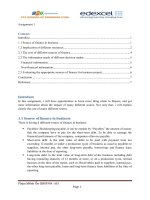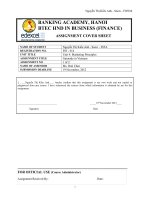1625 assignment 1 (pass)
Bạn đang xem bản rút gọn của tài liệu. Xem và tải ngay bản đầy đủ của tài liệu tại đây (923.33 KB, 33 trang )
Higher Nationals in Computing
Unit 06: Managing a Successful Computing
Project
ASSIGNMENT 2
Assessor name: NGO QUOC ANH
Learner’s name: Đào Vĩnh Khang
ID: GCS200222
Class: GCS0905B
Subject code: 1625
Assignment due: 3 1/ 0 1 / 2023
Assignment submitted: 3 1/ 0
lOMoAR cPSD| 22371689
ASSIGNMENT 2 FRONT SHEET
Qualification
BTEC Level 5 HND Diploma in Computing
Unit number and title
Unit 06: Managing a Successful Computing Project
Submission date
Date Received 1st submission
Re-submission Date
Date Received 2nd submission
Student Name
Đào Vĩnh Khang
Student ID
GCS200222
Class
GCS0905B
Assessor name
Ngo Quoc Anh
Student declaration
I certify that the assignment submission is entirely my own work and I fully understand the consequences of plagiarism. I understand that
making a false declaration is a form of malpractice.
lOMoAR cPSD| 22371689
Student’s signature
Grading grid
P5
P6
P7
M3
Summative Feedback:
Grade:
IV Signature:
M4
D2
Resubmission Feedback:
Assessor Signature:
Date:
lOMoAR cPSD| 22371689
Learning Outcomes and Assessment Criteria
Pass
Merit
Distinction
LO1 Establish project aims, objectives and timeframes based on the chosen theme
LO1 & LO2
P1 Devise project aims and objectives
for a chosen scenario.
D1. Critically evaluate the
P2 Produce a project management plan
that covers aspects of cost, scope, time,
quality, communication, risk, and
resources.
M1 Produce a comprehensive
project management plan,
milestone schedule and project
schedule for monitoring and
completing the aims and
objectives of the project.
project management
process and appropriate
research methodologies
applied.
P3 Produce a work breakdown structure
and a Gantt Chart to provide timeframes
and stages for completion.
LO2 Conduct small-scale research, information gathering and data collection to
generate knowledge to support the project
P4 Carry out small-scale research by
applying qualitative and quantitative
research methods appropriate for
meeting project aims and objectives
M2 Evaluate the accuracy and reliability of
different research methods applied.
Table of Contents
A. RESEARCH ANALYSIS .......................................................................................................................................................................8
lOMoAR cPSD| 22371689
I. Tools to assist data collection ...............................................................................................................................................................8
1. Interview......................................................................................................................................... Error! Bookmark not defined.
2. Survey...............................................................................................................................................................................................8
II. Analysis and Evaluation result ............................................................................................................................................................8
1. Interview...........................................................................................................................................................................................8
2. Survey...............................................................................................................................................................................................9
B. RECOMMENDATIONS ......................................................................................................................................................................20
I. Summary of the Android phone screen time limit function ...............................................................................................................20
II. List of features that should be included in the system ...................................................................... Error! Bookmark not defined.
III. Advantages and disadvantages of the time-limited function on the Android operating system ......................................................24
C.REFLECTIONS .....................................................................................................................................................................................25
I. Logbook ..............................................................................................................................................................................................25
II. Evaluation of research results............................................................................................................................................................30
1. Result evaluation ............................................................................................................................................................................30
2. Problems learned from the project ................................................................................................. Error! Bookmark not defined.
D. EVALUATIONS .................................................................................................................................. Error! Bookmark not defined.
I. Evaluate the success of the project according to the plan I set out .................................................... Error! Bookmark not defined.
2. The things I have done in the plan ......................................................................................................... Error! Bookmark not defined.
3. What are problems when implementing the plan .................................................................................. Error! Bookmark not defined.
lOMoAR cPSD| 22371689
List of Pictures
Figure 1 - Age to participate in the survey ................................................................................................................................................. 8
Figure 2 - Are survey participants using the Android operating system?................................................................................................... 9
Figure 3 - User's daily phone usage ............................................................................................................................................................ 9
Figure 4 - Has the user ever been affected by their health? ...................................................................................................................... 10
Figure 5 - Have you ever tried to limit your phone usage time? .............................................................................................................. 10
Figure 6 - User interest in the time limit function .................................................................................................................................... 11
Figure 7 - Do users think limiting their usage time can help them have better health? ............................................................................ 11
Figure 8 - Correlation between cell phone usage time and likelihood of having certain diseases ........................................................... 12
Figure 9 - Correlation between people who have had health problems and their search for solutions that improve their cell phone use
too much.................................................................................................................................................................................................... 13
Figure 10 - Correlation between people who have had health effects and their consent to reduced usage time will improve health. .... 13
List of Tables
Table 1 - List of features that should be included in the system ............................................................................................................... 16
Table 2 - Logbook (week 1 to 5) .............................................................................................................................................................. 21
lOMoAR cPSD| 22371689
lOMoAR cPSD| 22371689
A. RESEARCH ANALYSIS
I. Tools to assist data collection.
Evaluation: After using the method of personal interview to gather information about the problem I have been researching, I feel that
the interview is a popular, effective method that people often use to gather data. Precise and objective. This approach can be implemented
relatively easily. Can be interviewed directly, or via internet video call interviews. And it has produced the positive results I had expected.
Survey
For the survey I did create a form on Google Forms to send to people to collect data. I use Google Form because it is easy to use for
both me and the respondents, moreover it also can synthesize survey results by chart, so it is very convenient for analyzing survey
results.
Using the survey method has helped me synthesize all the responses of each user who responded to the survey. I can compare these
results or use coding to analyze the correlation between two variables to find out how they are related to each other. But there is one
point to note when surveying is whether users respond according to their thoughts or what influences them to choose that answer. This
is very important because it directly affects my analysis of the survey results.
Evaluation: Google form is really a good resource for creating surveys, simple to create surveys and send them to anyone. It aggregates
the results on one tab, which is easy to see and easy to use. Also, Google form supports results analysis. Really very convenient.
II. Analysis and Evaluation result
1. Method
There are several tools that can assist in data collection for the topic of automatic robotic vacuum cleaners controlled by smartphones.
Here are some of them:
lOMoAR cPSD| 22371689
Online Surveys: Platforms like Google Forms or SurveyMonkey can be used to create online surveys that can be easily distributed to a
large group of people. These surveys can include questions related to customer preferences, features they are looking for in a vacuum
cleaner, their willingness to pay, etc.
Focus groups: Focus groups involve a small group of people (typically 6-10) who are brought together to discuss a specific topic. This
method can be useful for collecting qualitative data and getting detailed feedback on specific features or aspects of the product.
Interviews: One-on-one interviews can be conducted either in person or over the phone to gather more in-depth information about
customer preferences, behaviors, and attitudes.
Social Media Monitoring: Social media platforms like Twitter, Facebook, and Instagram can be used to monitor conversations related
to robotic vacuum cleaners. This can provide insights into what customers are saying about existing products and what they would like
to see in future products.
Observational Studies: Observational studies involve observing and recording customer behavior in real-life situations. This method can
provide insights into how customers are currently using robotic vacuum cleaners and what features they find most useful.
Online Reviews: Online reviews on platforms like Amazon or Best Buy can provide valuable feedback on what customers like and
dislike about existing products. This can be used to identify areas for improvement or to inform the development of new features.
By using these tools, researchers can collect a variety of data types, including quantitative and qualitative data, to gain a comprehensive
understanding of customer preferences and needs related to automatic robotic vacuum cleaners controlled by smartphones.
2. Survey
First, to do the survey I need to prepare a set of questions to send to the user for them to answer and send the results back to me for me
to analyze and evaluate.
Survey questionnaire:
lOMoAR cPSD| 22371689
lOMoAR cPSD| 22371689
lOMoAR cPSD| 22371689
lOMoAR cPSD| 22371689
Review google form for research paper
Google Form is a very useful tool in conducting surveys and collecting data for research paper. Here are some reviews of Google
Forms:
Easy to use: Google Form is designed to be simple to use, users can create a questionnaire and share it with those who want to take part
in the survey in just a few minutes.
Save time: Google Form automatically generates spreadsheets to store data and provides a set of analytical tools to analyze data easily
and quickly.
Flexibility: Google Forms allows users to customize questions, add images and videos to make it easier to answer questions. In addition,
Google Form also allows users to customize the form of answers, such as multiple choice answers, checkboxes, or free responses.
Ability to analyze results: Google Form provides professional data analysis tools such as charts, tables, and filters. As a result, users can
analyze the data collected from the survey and draw useful conclusions for the research paper.
Free: Google Form is a free tool that does not require users to pay any fees to use its features.
Although Google Forms have many advantages and advantages for surveying and data collection, there are still certain
inconveniences and limitations. Here are some inconveniences of Google Forms:
lOMoAR cPSD| 22371689
Limit the number of questions: Google Form has a limit on the number of questions in a questionnaire, so you need to allocate and
organize the questions properly to get the most out of the number of questions per table .
Design limitations: Although Google Forms offers many design options, it still has limitations in terms of customizing the question form
and questionnaire layout.
No animations supported: Google Forms don't allow animations to be inserted into questions or answers, so you can't use animations or
videos to illustrate your point.
No powerful data analysis features: Although Google Forms allows direct viewing of answers through Google Sheets spreadsheets, its
data analysis features are not as powerful and refined as other tools. Professional data analysis.
No custom encoding: Google Form doesn't allow custom coding, so you can't encrypt your survey data using custom methods.
lOMoAR cPSD| 22371689
Figure 1 - Age to participate in the survey
Figure 2 - Are survey participants using the Android operating system?
lOMoAR cPSD| 22371689
Figure 3 - User's daily phone usage
lOMoAR cPSD| 22371689
Figure 4 - Has the user ever been affected by their health?
lOMoAR cPSD| 22371689
Figure 5 - Have you ever tried to limit your phone usage time?
lOMoAR cPSD| 22371689
Figure 6 - User interest in the time limit function
Figure 8 - a
robotic vacuum cleaner
lOMoAR cPSD| 22371689
Finally, I found a correlation between the two variables, that of people with health problems, with the variable that they believe
limiting daily phone time will improve their health. There is a similarity between these two variables, that is, if the proportion of
people who have experienced health problems due to excessive cell phone use, they will be more likely to believe that time is up. term.
Using it will help them have better health.
Summary of interview results: Most of the survey respondents are young people between the ages of 18 and 30 and reach most
customers from Android users to those using this operating system. other. At the same time, users are addicted to using their phones,
and they often use their phones more than 4 hours a day. But they are all looking for ways to reduce their phone use too much because
they believe that reducing phone time will help them have better health. Finally, users are eager to experience the automatic robotic
vacuum cleaner controlled by smartphone
B. RECOMMENDATIONS
I. Summary of the automatic robotic vacuum cleaner controlled by smartphone screen time limit function
After analyzing the collected data, I will generalize my system as follows: Carrying out an update to the Android operating system to
limit the time using the phone. This function can help users to set the usage time limit for each application in one day but with the
requirement not to exceed the time limit of 4 hours. This function will help users to manually adjust the color of the screen by the hour
to limit the bad dynamic separation of the user's eyes due to excessive exposure to blue light from the phone. It is then possible for the
user to set a bedtime but with a requirement not to be less than 6 hours to ensure the user's sleep. If the set time has been set, the phone
will notify the user to stop using it to sleep.
Here are some illustrations of the time limit functionality on the automatic robotic vacuum cleaner controlled by smartphone:
lOMoAR cPSD| 22371689
lOMoAR cPSD| 22371689
II. List of features that should be included in the system.
lOMoAR cPSD| 22371689
No
1
Function
Remote control using smartphone app
De
The ability to control the
app provides convenien
pause, and stop clea
2
Scheduling feature to set cleaning times in advance
This feature allows us
advance, so the robot vacu
at the designated time wit
3
Obstacle detection and avoidance sensors to prevent
collisions
Sensors on the robot vacu
avoid them, preventing
vacuum
4
Multi-room mapping and navigation capabilities
Advanced robot vacuum
rooms in a home, ensur
lOMoAR cPSD| 22371689
5
Self-charging feature to return to charging dock when
low on battery
When the robot vacuum d
its charging dock to recha
for the ne
III. Advantages and disadvantages
Advantages:
Advantages: The robot vacuum system through a smartphone application brings convenience to users in the process of house cleaning.
Better monitoring: Users can check, monitor and track the vacuuming progress through the smartphone app, giving them a
comprehensive view of the house cleaning process.
Schedule activities: The robot vacuum cleaner system via smartphone application allows users to schedule cleaning activities in real
time or in real time.
Obstacle detection and avoidance: The robot vacuum cleaner is equipped with sensors to detect and avoid obstacles on the way, helping
to avoid collisions and damage to objects in the house.
lOMoAR cPSD| 22371689
Mapping feature: The robot vacuum cleaner can create a map of the cleaning space and optimize its path, which increases cleaning
efficiency and saves time.
Disadvantages:
Advantages: The robot vacuum system through a smartphone application brings convenience to users in the process of house cleaning.
Better monitoring: Users can check, monitor and track the vacuuming progress through the smartphone app, giving them a
comprehensive view of the house cleaning process.
Schedule activities: The robot vacuum cleaner system via smartphone application allows users to schedule cleaning activities in real
time or in real time.
Obstacle detection and avoidance: The robot vacuum cleaner is equipped with sensors to detect and avoid obstacles on the way, helping
to avoid collisions and damage to objects in the house.
Mapping feature: The robot vacuum cleaner can create a map of the cleaning space and optimize its path, which increases cleaning
efficiency and saves time.
C.REFLECTIONS
I. Logbook
Name:









